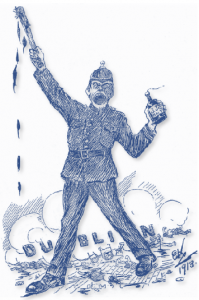
Labour-related violence plagued Dublin from February 1913 to February 1914. During August and September 1913 alone there were fifteen distinct and separate riots, a number of which resulted in large-scale clashes between workers and the Dublin Metropolitan Police (DMP). Twelve occurred on Saturday 30 and Sunday 31 August (five and seven respectively). The findings of the Dublin Disturbances Commission established that only a few of these riots had their origin in organised tramcar attacks, while the remainder predominantly originated in organised attacks on the police. Two men died and hundreds were injured.
DMP exonerated by commission of inquiry
The relationship between the police and the public had been charged for some time. This state of affairs had been escalating for months before erupting into a series of major riots. Dublin newspapers carried daily reports of court proceedings arising out of assaults on the police on duty. There was tension and inevitable hostility between the DMP and the people. Enquiries made in early September determined that there were 910 policemen on duty in Dublin in connection with the Lockout. The force was comprised of 500 DMP (nearly half the total strength) and 410 men from the Royal Irish Constabulary (RIC) drawn from all over the country. Between August and December 1913 some 656 people were arrested; nearly two thirds (416) were convicted and imprisoned. The inquiry into the disturbances concluded that these riots were not confined to working men only, for in all of them ‘the worst element was supplied by those who seldom or never work, and who may be described as the corner-boys and criminal class in the city’. Roughly half of those imprisoned had previous convictions.
These events not only divided society into trade unionists and ‘scabs’ but also placed the civic police force on the other side of the barricades from the community it was meant to serve. Since its inception, the DMP’s objective was to prevent crime and preserve peace. The viceregal commission appointed to inquire into the conduct of the police during the riots found that the DMP men did precisely that and discharged their duties with courage and patience. The total number of constables injured in the riots exceeded 200.
Unprovoked attacks
The press coverage of the day provides conflicting evidence, however. Reports quoted witnesses who testified to unprovoked violence from the police armed with batons, indiscriminately charging at the crowds. Likewise, during a cross-examination two witnesses swore on oath that they saw the police attack Liberty Hall, the headquarters of the Irish Transport and General Workers’ Union, without any provocation. A witness, Charles M’Day, stated that he saw the police rush across and clear the square in front of the hall. He then saw other police come down from O’Connell Bridge, and on running towards Eden Quay he witnessed ‘James Nolan being struck by 224C with a baton on the side of the head near the ear’. James Nolan was one of the two men killed during the riots. He sustained a fracture of the skull, which resulted in his death at Jervis Street Hospital on the morning of Sunday 31 August, the day after he sustained his injury during the night riot. The post-mortem examination found that the injury was caused by the blow of a baton.
Other accounts state that the police retaliation was in response to the showers of stones that rained down on them from the windows of the surrounding buildings. Stones, bricks, and bottles were thrown by the crowd. The riot in this locality went on for some time and while it lasted, according to the commission of inquiry, the throwing of stones and bottles was almost continuous, and many injuries were inflicted.
Working men themselves

The DMP constables, working men themselves, were placed in a precarious position. The orders to provide protection to the Tramway Company in running their cars notwithstanding, the strike created greater resentment against the police. Jim Larkin’s rhetoric was to the effect that a non-union worker, or a scab, was a traitor to his class, a deserter who went over to the enemy in time of war to fight against his own people. Even though the policemen were inadvertently made into accomplices in this ‘war’, an overwhelming majority of DMP recruits were of labouring (albeit rural) stock themselves. Many of them enlisted to secure modest but stable incomes for their families. HI
Anastasia Dukova was awarded a Ph.D in history by Trinity College, Dublin, and is currently conducting postdoctoral research at the University of Toronto.
Read More : Police pay and conditions
Further reading
A. Wright, Disturbed Dublin. The story of the great strike of 1913–14 (London, 1914).

